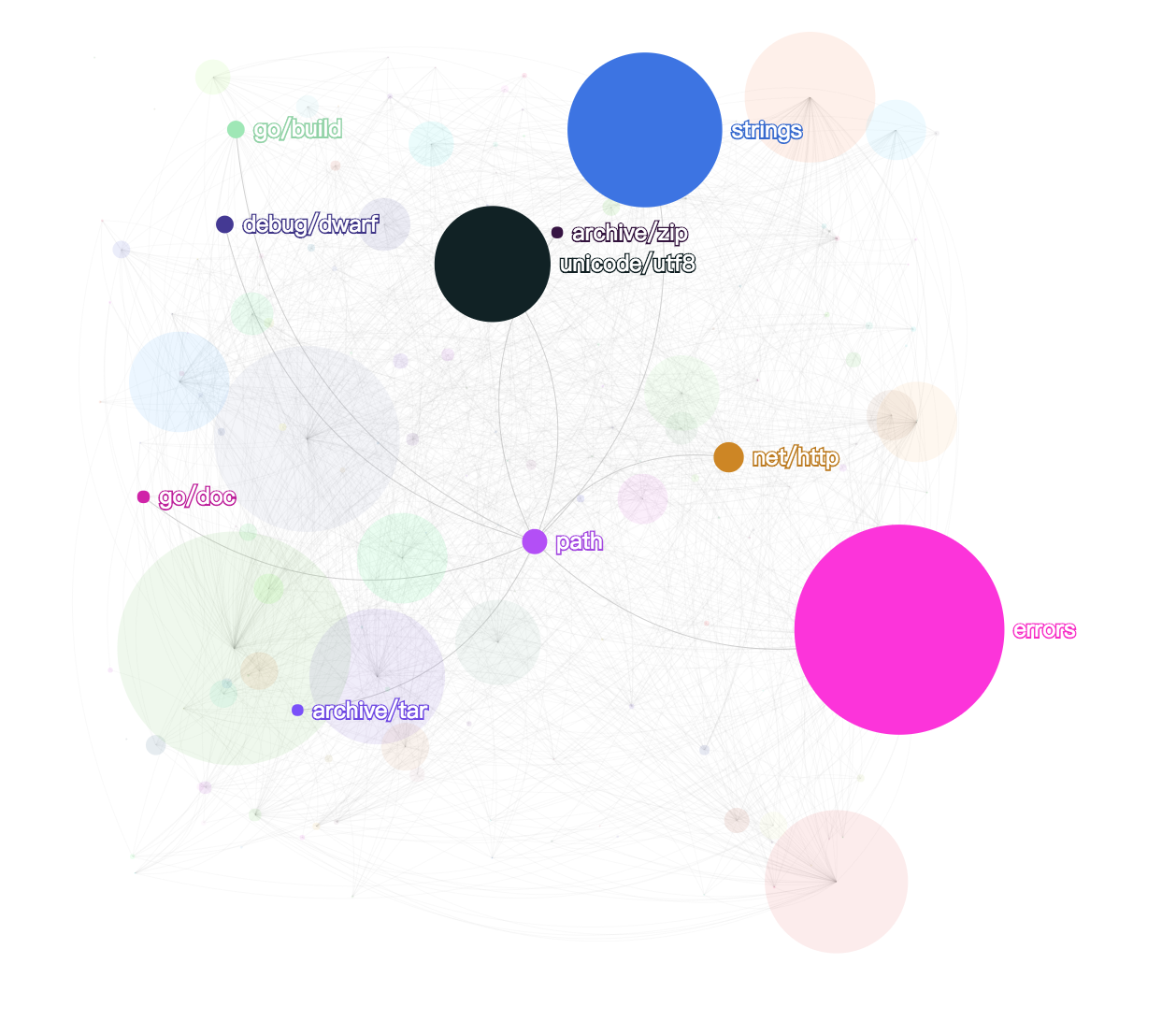golang 标准库间依赖的可视化展示
简介

国庆看完 << Go 语言圣经 >>,总想做点什么,来加深下印象.以可视化的方式展示 golang 标准库之间的依赖,可能是一个比较好的切入点.做之前,简单搜了下相关的内容,网上也要讨论,但是没有发现直接能拿过来用的.标准库之间,是必然存在依赖关系的,不同库被依赖的程度必然是不一样的.但究竟有多大差别呢?
以下内容,数据源自真实环境的 golang 1.9 版本的标准库.所以,本文不仅是一篇可视化相关的讨论文章,更是提供了一个可以直接探究 golang 标准库间依赖关系的快速梳理工具.
数据准备
标准库各个包之间的相互关系,可以直接通过命令获取,然后简单变换为一个标准的 JSON 对象:
go list -json std
示例输出:
{
"Dir": "/usr/local/go/src/archive/tar",
"ImportPath": "archive/tar",
"Name": "tar",
"Doc": "Package tar implements access to tar archives.",
"Target": "/usr/local/go/pkg/darwin_amd64/archive/tar.a",
"Goroot": true,
"Standard": true,
"StaleReason": "standard package in Go release distribution",
"Root": "/usr/local/go",
"GoFiles": [
"common.go",
"format.go",
"reader.go",
"stat_atimespec.go",
"stat_unix.go",
"strconv.go",
"writer.go"
],
"IgnoredGoFiles": [
"stat_atim.go"
],
"Imports": [
"bytes",
"errors",
"fmt",
"io",
"io/ioutil",
"math",
"os",
"path",
"sort",
"strconv",
"strings",
"syscall",
"time"
],
"Deps": [
"bytes",
"errors",
"fmt",
"internal/cpu",
"internal/poll",
"internal/race",
"io",
"io/ioutil",
"math",
"os",
"path",
"path/filepath",
"reflect",
"runtime",
"runtime/internal/atomic",
"runtime/internal/sys",
"sort",
"strconv",
"strings",
"sync",
"sync/atomic",
"syscall",
"time",
"unicode",
"unicode/utf8",
"unsafe"
],
"TestGoFiles": [
"reader_test.go",
"strconv_test.go",
"tar_test.go",
"writer_test.go"
],
"TestImports": [
"bytes",
"crypto/md5",
"fmt",
"internal/testenv",
"io",
"io/ioutil",
"math",
"os",
"path",
"path/filepath",
"reflect",
"sort",
"strings",
"testing",
"testing/iotest",
"time"
],
"XTestGoFiles": [
"example_test.go"
],
"XTestImports": [
"archive/tar",
"bytes",
"fmt",
"io",
"log",
"os"
]
}
梳理过的数据源,参见: https://raw.githubusercontent.com/ios122/graph-go/master/data.js
可视化原理
主要涉及一下内容:
-
可视化显示,使用的是 echarts
-
使用原始数据的 ImportPath 而不是 Name,来作为每个数据节点的唯一id.这样是因为 golang 本身的包命名规范决定的.
-
使用原始数据的 Imports 字段,来确定标准库包与包之间的相互依赖关系.golang是不允许循环依赖的,所以一些循环依赖相关的问题,不需要考虑.
-
节点的大小,和包被其他包引入的次数成正相关.这样做,被依赖越多的包,图上最终显示时,就会越大.常用包和不常用包,一目了然.
数据整理
就是把原始数据,处理成 echarts 需要的数据,这里简要说下最核心的思路:
-
echarts 显示相关的代码,很大程度上参考了 graph-npm
-
节点坐标和颜色,采用随机坐标和颜色,以去除节点和包之间的联系.我认为这样处理,能更纯粹地观察标准库包与包之间的联系.
-
需要一个 edges 来记录包与包之间的依赖关系.在每次遍历 Imports 时,动态写入.
-
需要一个 nodes 来记录包自身的一些信息,但是其 size 参数,需要计算过所有依赖关系后再填入.
-
使用 nodedSize 来记录每个包被依赖的次数,为了提升效率,它是一个字典Map.
/* 将原始数据,转换为图标友好的数据.
ImportPath 作为唯一 id 和 标签;
Imports 用于计算依赖关系;
节点的大小,取决于被依赖的次数;
*/
function transData(datas){
/* 存储依赖路径信息. */
let edges = []
/* 存储基础节点信息. */
let nodes = []
/* 节点尺寸.初始是1, 每被引入一次再加1. */
let nodedSize = {}
/* 尺寸单位1. */
let unitSize = 1.5
datas.map((data)=>{
let itemId = data.ImportPath
nodes.push({
"label": itemId,
"attributes": {},
"id": itemId,
"size": 1
})
if(data.Imports){
data.Imports.map((importItem)=>{
edges.push({
"sourceID": importItem,
"attributes": {},
"targetID": itemId,
"size": unitSize
})
if(nodedSize[importItem]){
nodedSize[importItem] = nodedSize[importItem] + unitSize
}else{
nodedSize[importItem] = unitSize
}
})
}
})
/* 尺寸数据合并到节点上. */
nodes.map((item)=>{
let itemId = item.id
if(nodedSize[itemId]){
item.size = nodedSize[itemId]
}
})
return {
nodes,edges
}
}
效果与源码
- github 源码: https://github.com/ios122/graph-go
- echarts 在线预览: http://gallery.echartsjs.com/editor.html?c=xSyJNqh8nW



 国庆看完 << Go 语言圣经 >>,总想做点什么,来加深下印象.以可视化的方式展示 golang 标准库之间的依赖,可能是一个比较好的切入点.做之前,简单搜了下相关的内容,网上也要讨论,但是没有发现直接能拿过来用的.标准库之间,是必然存在依赖关系的,不同库被依赖的程度必然是不一样的.但究竟有多大差别呢?
国庆看完 << Go 语言圣经 >>,总想做点什么,来加深下印象.以可视化的方式展示 golang 标准库之间的依赖,可能是一个比较好的切入点.做之前,简单搜了下相关的内容,网上也要讨论,但是没有发现直接能拿过来用的.标准库之间,是必然存在依赖关系的,不同库被依赖的程度必然是不一样的.但究竟有多大差别呢?

